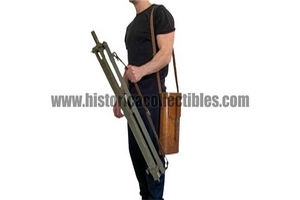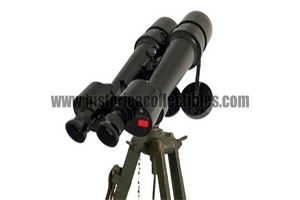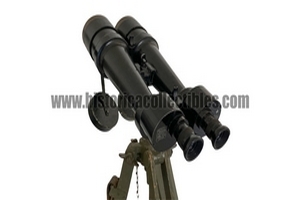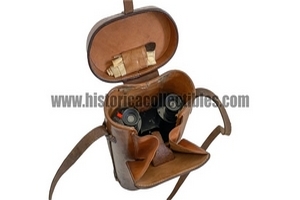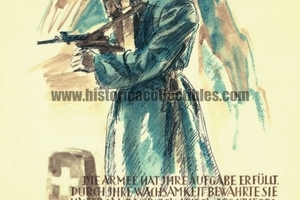Doppelfernrohr 15x60, Carl Zeiss Nedinsco 's-Gravenhage, Swiss Army, circa 1921
Doppelfernrohr D.F. 15x60, produced by Carl Zeiss Jena Nedinsco 's-Gravenhage in around 1921, complete with its original leather case as well as the original tripod. It is one of the first and very few binoculars known with these characteristics, made and intended for the Swiss Army.
On the right eyepiece plate, beyond the Swiss cross, you can see the number XXX followed by the letter G., which presumably refers to the registration system that Nedinsco used to catalog instruments and binoculars intended for the Swiss army. Or a real serial number referring to a specific department of the Swiss Army.
I believe that these binoculars were produced in the first year of activity of Carl Zeiss Nedinsco 's-Gravenhage, that is, in 1921, in a limited number of examples. This is in light of the tragic economic crisis that hit Switzerland in 1920 and taking into account the fact that, in a much more prosperous period, 1938, Carl Zeiss Jena produced, for the Swiss army, only 56 examples of the same model.
This binoculars, magnificently preserved, is perfectly functional in all its mechanical parts, it has extraordinarily sharp lenses which provide exceptional visual brightness and image definition comparable only to very few other models, even those of recent production.
The reason why it is believed that few examples were produced is supported by the event of the great economic crisis that hit Switzerland in 1920. In fact, federal councilor Karl Scheurer, forced to implement restrictions by minimizing the expenses incurred to maintain the army, decided to reduce the quota of those fit for service, raise the age for recruit school to 21 and use ammunition and material intended for war reserves. The organization of the troops in 1925 was a weak reform which was limited to the introduction of light machine guns.
Only after 1933, when Adolf Hitler came to power, to contribute to the costs of rearmament, the Swiss people subscribed to a National Defense Loan of 235 million francs in 1936. The infantry was strengthened with an initial supply of the necessary support weapons (mine launchers, infantry cannons). Reconnaissance tanks were purchased for the light troops, while the horse-drawn artillery pieces were partly replaced by motorized vehicles. The air force was strengthened with Messerschmitt aircraft, while the anti-aircraft defense was set back.
In a subsequent period, economically flourishing like 1938, the Swiss army commissioned only 56 15x60 binoculars from Zeiss, this leads us to deduce that in 1921, an event of great economic crisis, it would not have been possible to commission more than 10 examples.
The Federal Council's 1939 Ordinance on Complementary Service also allowed women access to military service, albeit with some restrictions. All periods of instruction were extended. The nine divisions (each made up of three regiments) and the three autonomous mountain brigades were entrusted with the direction of the combat. Their level of motorization was modest: they moved on foot, with the help of draft horses. Eight border brigades, together with the border troops of the Gotthard division and the mountain brigades, were to contain the first assault in the event of a sudden attack, allowing the mobilization of the field troops: the permanent fortifications were designed to offer them a support. Three light brigades, composed of cavalry, cyclists and motorized troops were tasked with fighting to gain time.
Nedinsco (Ned-Ins-Co in Dutch "Dutch Instrumentation Company") was founded in 1921 by Carl Zeiss of Jena following an acquisition of an old disused factory, located in the city of Venlo, Holland. Thanks to a man, Franz Kaumanns, who sympathized with Germany, Carl Zeiss managed to avoid the restrictions imposed in the Treaty of Versailles, in which Germany was not allowed to produce war material for its army; Article 168-170 in fact imposed rigorous controls on the production of war material and the consequent export.
In the same year the production of rangefinders, periscopes and signal lamps for military use began.
In 1921 Franz Kaumanns, as delegate representative of Carl Zeiss in the Netherlands, opened the corporate and representative headquarters in the city of Gravenhage.
In 1923, Zeiss entrusted the architect Hans Schlag with the task of designing the expansion of the factory, building a tower suitable for aligning the optical instruments and calibrating them over longer distances, focusing on the bell towers of Venlo, which this city boasted a large number of them.
In 1944 the factory was destroyed by a violent bombing.
After World War II, Nedinsco became an independent company.
Carl Zeiss takes its name from its founder, Carl Zeiss, who on November 17, 1846 chose the small town of Jena, in Thuringia, as the location for his precision optical equipment factory. Thanks to the severe quality control that Carl Zeiss imposed on his products, going so far as to personally destroy the microscopes that did not pass the tests, the newly formed Zeiss became the official supplier of the University of Jena and received the gold medal of the industrial exhibition in 1861 of Thuringia as the best research instrument produced in Germany, awarded to the Stand I microscope of 1857. In 1866 the thousandth microscope was produced and the name Zeiss became known in all European scientific circles. Thanks to studies on the Porro prism, in 1893 Abbe patented double prism binoculars, which accentuated the perception of depth.
The mass production of Zeiss binoculars began in 1894, already at the beginning of the twentieth century more than 30,000 were made, at the beginning of the First World War the quota had risen to 500,000 and, at the end of the Second World War, as many as 2,260,000 were produced binoculars for the civil and military market. Models were made starting from 4x11 mm to 12x40 mm, up to real giants such as the 80 mm and 100 mm. Thanks to studies conducted on the perception of light in low light situations, it was demonstrated that the average dilation of the pupil in an adult is approximately 7 mm. For this reason, the 7x50 mm model was introduced in 1910 and remained on the market until 1917 with few changes to the materials used.
In 1926, following the post-war crisis of the First World War with the Treaty of Versailles which bankrupted many important German companies, Zeiss purchased "C.P. GOERZ" and founded Zeiss Ikon in 1926. In 1937 Zeiss had commercial contacts and factories in more than 29 countries around the world. From '33 Zeiss acquired interest from the Nazi regime, which balanced production towards military instruments. It successfully produced binoculars with wide-angle optics for military use, pressure-resistant optical systems for U-boats, periscope binoculars for targeting tanks. Furthermore, Zeiss cameras were mounted on the V2s for remote sensing operations of the English coasts.
On 1 November 1935, Zeiss, in the figure of Alexander Smakula, patented a process for the treatment of optical glass with extraordinary results in terms of light transmission. Remained a military secret until 1939, it was adopted on binoculars to reduce ghost images and internal reflections. During the Second World War, there were numerous bombings against the Zeiss factories.
Jena was bombed several times by the Allies starting in 1944. Stuttgart was razed to the ground, although the Contessa-Nettel factory suffered little damage. The bombing of Dresden, in addition to devastating the city, also caused considerable damage to the Zeiss Ikon headquarters.
On April 13, 1945, American military forces entered Jena, surprising themselves that the bombing had not caused any significant damage. The main planetarium was in ruins, while the factories remained operational.

